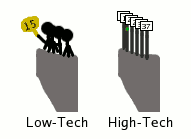Wrong Tech for the Context: Fry’s Line Spotters
If you’re going to replace an old technology with a new one, make sure it’s actually an improvement in the context in which it’s used.
Case in point: the line spotters at Fry’s.
Fry’s was a chain of gigantic computer/electronics stores. They sold hardware, software, and components, TVs, CDs and DVDs, stereos, phones, kitchen appliances and kitchy appliances. It was the only computer store I know of with a snack food aisle, and the stores are usually converted warehouses. I’m talking huge.
The checkout lane was set up as a long counter with several dozen checkout stations with a single line running parallel to the counter. An employee would stand on a stool at the front of the line to direct customers to the next available cashier
When they first opened a store nearby, each checker had a numbered sign on a handle they would raise whenever they finished with a customer, and the spotter would see it and direct the next person in line. If the checker held the sign up backwards, it indicated they needed a supervisor to assist.
At some point they installed a pole with a pair of red and green lights and a number at the top or each station. The green light indicates the cashier is ready, and the red light indicates they need a supervisor. Sounds good — you don’t need to worry about losing the signs, or getting them in the right order, the checkers don’t need to hold the signs above their head, etc.
But think about this. Remember, the spotter is looking at this from one end of the row:

Now, which of these makes it easier to see the number of the available station? You got it: the low-tech one. This doesn’t mean that using lights for this is a bad idea, but the way it’s done actually makes it worse than the old way of doing things.
One simple way to make it easier to read would be to make each pole a slightly different height, raising them higher as you go down the line so that you can see past the closer signs.
When I wrote this in 2004, it had already been several years. They were still using the “high tech” system as late as 2021 when the chain closed. Their employees just had to deal with it. Heck, by the end, some of them were probably younger than the system itself!